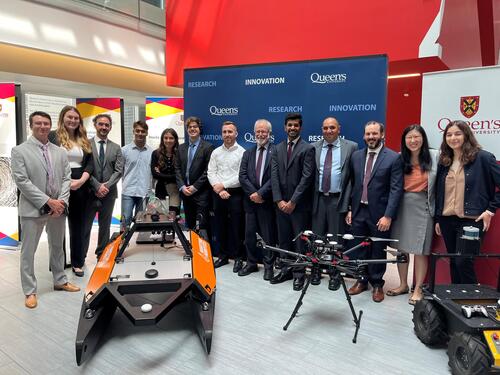“Come visit us, check out our space. Because once you do, you’ll understand what we could do for your business.”
The space Ramzi Asfour refers to is the airy, well-lit 1,115 square metre laboratory space occupied by the Ingenuity Labs Research Institute in the Mitchell Hall building. It’s not often that a university institute hands out this sort of open invitation. But then as Asfour, the institute’s Associate Director, makes quite clear, this is no ordinary academic institute.

Created in 2018, to help further research into artificial intelligence, robotics and human-robot interaction, there’s a sense of mission, for want of a better word, to the work of the institution. Simply, as Asfour puts it, “Our view is that robots and AI are going to be everywhere, we want to create the future intelligent systems and robotic machines for the benefit of our society.”
That’s a big claim, but it’s borne out by the researchers connected to the lab. Located physically and administratively within the Smith Engineering faculty, an outsider might assume that the 35 plus researchers and the more than 100 graduate students and post docs affiliated with Ingenuity Labs would be drawn largely from the ranks of engineering and computer science. And both those groups are well represented.
In fact, says Asfour, “We have members from engineering, computer science, the school of business, and rehabilitation therapy as well as the faculties, of arts and science, education and law.” So, yes, everywhere.
What these researchers gain is access to this space, which is configurable in almost any way imaginable depending on the project. And perhaps more important is the shared research equipment that Ingenuity Labs can offer them. This is technology that, especially in the early stages of their careers, fledgling researchers might have neither the time nor the money to purchase.
“We can have three or four teams working on the same piece of equipment,” says Asfour. “It doesn’t sit idle.”
Ingenuity Labs can offer researchers everything from industrial scale drones to a twelve-camera, motion-picture capture system, useful both for developing autonomous vehicles or creating a fantastic virtual reality environment for the movies or video games. The research equipment also includes a Boston Dynamics Spot robot dog and a Unitree Go 1 robot dog. Ingenuity Labs also features two workshops, one for assembly and another for fabrication. The latter features a laser cutter and three 3D printers, including one which can embed carbon fibre in what it prints, making components that are almost as strong as aluminum.
Ingenuity Labs is also building out its own computer cluster to support research, a move that in 2022 already saved AI researchers doing cutting edge work about $1.3 million.
Queen’s researchers form a lot of Ingenuity Labs users, but Asfour and his colleagues are also keen on working with people and companies outside the university community. For example, these days they are cooperating on research into autonomous vehicles operating in fleets or in what is termed “unstructured environments” (operating off-road and on rough ground) with General Dynamics, whose GDLS division builds the light armoured vehicles or LAVs that are the that are the workhorse of Canada’s Army.
How will the control algorithms developed for use on roads and level ground function in these challenging environments? Researchers at Ingenuity Labs will help them find out.
There is, he says, virtually no one who couldn’t benefit from what they offer.
“If you’re in any business, and you think you need to automate and deploy robots and AI, come talk to us.”
This includes not only the more obvious beneficiaries – health, defence and industry 4.0 – but a few surprising ones, such as construction.
“If you’re in construction right now, we’re really interested,” he says. There’s a “dearth of labour,” which could possibly be solved by the use of robotics and AI.
“Could you use robotics for mass timber construction? Could you train a robot to drive in big screws safely and reliably? How would humans and robots work together on a construction site? They want to find out. There are challenges, but we can start to work on it,” says Asfour.
The maritime industry is another area they hope to get involved in. Among the lab’s equipment is a fully autonomous boat, capable of moving on its own for 24 hours.
“We’re looking to do a big project to launch freshwater robotics,” he says. The boat, working in conjunction with submersibles and drones could be used to survey a body of water from the sky overhead right down to the lake floor.
“With an effluent plume,” he says, “you could actually get a whole 3D view.”
Whatever their interests, he says, “Come, talk to us. We have lots of ways to set up a pilot project.”
Interested in partnering with Ingenuity Labs or other Queen’s researchers? Queen’s Partnerships and Innovation can help you connect with the right people and the right ideas. For further information, contact our Senior Director, Research and Innovation Partnerships kelly.nolan@queensu.ca.
 About Vice-Principal Research
About Vice-Principal Research